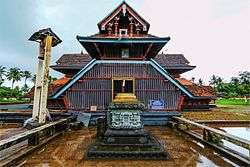Vazhappally copper plate
Vazhappally copper plate (9th century AD) is a copper plate inscription in Malayalam language from Vazhappally, in the state of Kerala, south India. It is one of the earliest available epigraphical records mentioning a Chera Perumal ruler of Kerala.[1][2] Recent scholarship puts the date of the plate in c. 882/83 AD.[3]
.jpg)
The inscription is engraved on a single copper plate (with five lines on both sides) in an early form of Malayalam in Vattezhuthu script with some Grantha characters. The contents of the plate are incomplete.[1] The inscription was discovered by V. Srinivasa Sastri from Talamana Illam near Changanassery.[4] The plate is owned by Muvidathu Madham, Thiruvalla.[1]
The record is dated to the twelfth regnal year of king Rajasekhara.[1]
- King Rajasekhara is described as "Sri, Raja Rajadhiraja, Parameswara Bhattaraka, Rajashekhara Deva" and "the Perumal Atikal".[1]
- The copper plate describes a temple committee resolution by Thiruvatruvay Pathinettu Nattar and the Urar of Vazhappally in the presence of king Rajasekhara on a land grant for the daily worship in the Thiruvatruvay temple.[1]
- The fines for those who obstruct the daily worship in the temple are also prescribed.[1]
- Begins with the invocation "Namah Shivaya" ("Respect to Shiva") in place of the usual "Swasti Sri" ("Hail! Prosperity!").[1]
- Also mentions a coin called "dinara".[1]
The Vattezhuthu characters in the Vazhappally copper plate are noted for their similarity to the Madras Museum Plates of Jatila Varman Parantaka Pandya. The Grantha characters in the plate have a late character with respect to the Kasakudi and other early Pallava grants. The plate also resembles Quilon Syrian copper plates (mid-9th century AD) in script and language.[5][4]
Chera/Perumal king Rajasekhara is usually identified by scholars with Cheraman Perumal Nayanar, the venerated Shaiva (Nayanar) poet-musician.[6]
Translation
_(cropped).jpg)
"Namah Shivaya! The [regnal] year twelve of Sri Rajadhiraja, Parameswara Bhattaraka, Rajashekhara Deva [was current].
"[The following was] the arrangement made by Thiruvattuvay Pathinettu Nattar and the Urar of Vazhappalli who met under the presidency of Rajashekhara Deva. Those who stop the perpetually endowed muttappali (the daily worship) in the Thiruvattuvay [Temple] should pay to the Peruman Atikal a fine of one hundred dinaras; and [are to be considered] as "Having Taken their [Own] Mothers for their Wives".
"Among the servants (the panimakkal), those who stop [the muttappali owning to their own negligence] should such pay a fine paddy as measured by and made up to four nazhis for occasion [muttappali is so stopped]. Of this the paddy due as padavaram (i.e., 10% share) should go the capital [set apart] for the shanthi [routine worship] and the [remaining] nine parts for the muttappali. [And] this fine should be remitted before the midday muttappali of the Pushya star in the month of Thai. If not so paid, they (the servants) become liable to pay twice the amount [as the penal interest].
"The following are the lands given to [the Lord of] Kailasa: the plot [kari], [belonging to] Kirankadambanar, which yields one year twenty and another year twenty five kalams [of paddy]; Mandilakkalam together with Ula[se]li [plots] yielding ten kalams [of paddy]; Kallattuvay veli [or a plot of land one veli in extend in Kallattuvay], yielding five hundred nazhis; from Kanjikka, five hundred nazhis; the Pilikkode puraiyidam and puraiyidam of Kannan Sankaran, who held the position of a kavadi, which adjoins it [Pilikkodu puraiyidam], both situated in Uragam and yielding one hundred and fifty thuni of paddy and three dinaras [respectively]; two velis in the matram in Aiyankadu... Damo[daran's]...
— Travancore Archaeological Series (Volume II)
References
- Narayanan, M. G. S. Perumāḷs of Kerala. Thrissur (Kerala): CosmoBooks, 2013. 435.
- Veluthat, Kesavan. "The Temple and the State in Medieval South India." Studies in People’s History, vol. 4, no. 1, June 2017, pp. 15–23.
- 'Changes in Land Relations during the Decline of the Cera State,' In Kesavan Veluthat and Donald R. Davis Jr. (eds), Irreverent History:- Essays for M.G.S. Narayanan, Primus Books, New Delhi, 2014. 58.
- Rao, T. A. Gopinatha. Travancore Archaeological Series (Volume II, Part II). 8-14.
- Narayanan, M. G. S. Perumāḷs of Kerala. Thrissur (Kerala): CosmoBooks, 2013. 63-64.
- Noburu Karashmia (ed.), A Concise History of South India: Issues and Interpretations. New Delhi: Oxford University Press, 2014. 143.
External links
- Mathew, Alex - Political identities in History (2006) Unpublished Doctoral Thesis (M. G. University)
